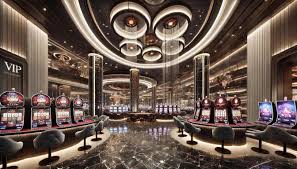
The Grandeur of Classic Casino Design
Casino architecture has long been synonymous with luxury, extravagance, and opulence. From the classic casinos of Monte Carlo to the glamorous resorts of Las Vegas, the architecture of a casino is often designed to evoke a sense of awe and excitement. Grandiose structures with towering facades, ornate decorations, and expansive interiors create an atmosphere of wealth and sophistication. These buildings are not merely places to gamble; they are architectural statements, carefully designed to captivate visitors and immerse them in an experience that goes beyond the gaming floor. Iconic structures like the Casino de Monte-Carlo, with its Baroque revival style, and the Bellagio in Las Vegas, featuring a Romanesque design, demonstrate the importance of architecture in setting the tone for the casino experience.
The Allure of Themed Casinos
Another defining trend in casino architecture is the rise of themed casinos, where design and construction take inspiration from a particular location, culture, or historical period. These casinos aim to transport visitors to a different time or place, offering a playful and immersive atmosphere that enhances the overall gambling experience. Examples include The Venetian in Las Vegas, which recreates the romantic charm of Venice with gondola rides and replicas of iconic landmarks, and the Luxor, which mimics the grandeur of ancient Egypt with its pyramid shape and sphinx statues. Themed architecture in casinos appeals to tourists who want more than just gaming – they seek a full sensory experience that makes them feel as though they’ve stepped into a different world.
Integration of Luxury and Functionality
While casino architecture focuses on creating an exciting and visually striking experience, it also places great emphasis on functionality. The layout of a casino is a key element in driving foot traffic and ensuring the flow of patrons throughout the space. Casinos are often designed with careful attention to detail, ensuring that gamblers can easily navigate between the gaming areas, restaurants, lounges, and entertainment venues. The use of space is crucial; designers strategically place gaming tables and slot machines to encourage movement and engagement while keeping visitors captivated with stunning interior designs. Lighting, furniture, and sound also play a significant role in creating an atmosphere that feels welcoming yet stimulating, ensuring that players feel immersed without becoming overwhelmed.
Sustainability in Modern Casino Design
As the world becomes more focused on sustainability and environmental responsibility, many modern casinos are incorporating eco-friendly features into their architecture. Green building practices, energy-efficient lighting, and the use of sustainable materials have become more common in recent years, as casinos seek to reduce their environmental footprint. For example, the Wynn Las Vegas incorporates sustainable architecture with its LEED Gold certification, featuring energy-efficient systems and environmentally friendly design elements. These innovations not only improve the casino’s environmental impact but also appeal to eco-conscious guests who appreciate seeing their favorite destinations adopt green practices. The integration of sustainability with luxury architecture is helping to redefine what it means to build a modern casino, blending style with environmental awareness.
The Future of Casino Architecture
As technology continues to evolve, the future of casino architecture is set to see even more innovative designs. With the rise of virtual and augmented reality, it is possible that casinos will integrate immersive, tech-driven experiences directly into their physical spaces. Interactive displays, holographic elements, and gamified environments may become part of the landscape, transforming the way people engage with casino design. Additionally, the growth of integrated resorts, which combine casinos with hotels, shopping, entertainment, and dining options, will likely continue to influence architectural trends. These multi-purpose complexes focus on offering a full-scale entertainment experience, requiring architects to balance functionality with innovative design. Ultimately, the future of casino architecture will blend tradition with cutting-edge technology, creating spaces that are not only visually striking but also functional, sustainable, and technologically advanced.
In conclusion, casino architecture plays a crucial role in shaping the overall gambling experience. From the grandeur of classic designs to the immersive environments of themed casinos and the growing focus on sustainability, the buildings that house these establishments are as important as the games they offer. Iconic structures like The Venetian and the Luxor have set a high standard for creative, engaging, and unforgettable casino environments. As technology and environmental concerns continue to influence design, the future of casino architecture will undoubtedly be marked by a new wave of innovation, blending luxury, functionality, and sustainability.
Download the app now, play amazing games, and start earning today!


